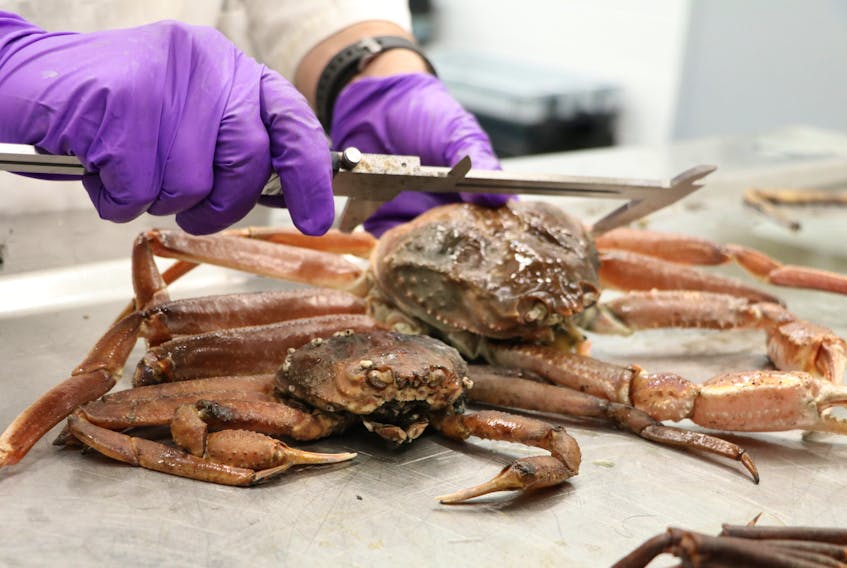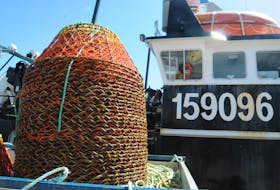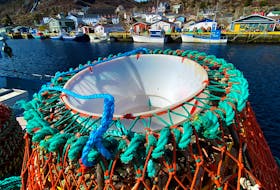New biological research on the province’s snow crab stocks presented Thursday shows that fewer male crabs are growing to a fishable size.
And because there are fewer large males in the snow crab population, the research has revealed, the crab are terminally molting at a small size because there is no need to grow larger to compete with large crab.
It’s a condition in nature that can happen when a stock is under stress.
Department of Fisheries and Oceans (DFO) shellfish biologists Darrell Mullowney and Krista Baker say high fishing pressure and low population density are contributing to the situation.
Continuing to fish at high levels, they say, could lead to long-term serious harm through genetic change or impaired reproductive capacity.
It’s not news the province’s fishing industry is going to want to hear after fishing quotas have already been dropping.
“We started noticing the population was looking something like this a few years ago — small, undersized males with deteriorated and old-looking shells,” Mullowney said, displaying snow crab at a laboratory at DFO headquarters in St. John’s.
“What the analysis showed was that the size and the (ocean) temperature were marginal factors leading to this phenomonen on the crab maturing at a smaller size, while population density and fishing pressure seem to be more important factors driving the situation.
“We want the size at maturity to be as large as possible in the crab stock to grow males to a size that they can contribute to the fishery. The crab used to have to grow large to compete with larger individuals. In the absence of the larger individuals, there is no need to grow large anymore.
“The thing that’s going on here, how we interpret the situation, is the importance of these big males is becoming revealed. And what they do is introduce intraspecific competition into the stock. And so this is competition for things like food and space and mates. You need to keep a mass of these big males in the population to promote others to grow large as well. Once the mass of these big males becomes low enough, it seems, what is occurring now may occur and that is there is no need to grow larger anymore.”
In 25 years of sampling the snow crab stocks around the province, it’s the first time researchers have seen the occurrence to such an extreme.
“I would categorize it as a serious concern,” Mullowney said.
The biologists noted the south coast of the province seems to be the only area not currently seeing this phenomenon.
“The south coast snow crab stock has seen some improvements in recent years and so they are seeing some bigger males in the population again,” Mullowney said. “The snow crab fishery is a unique one in that it is only big males that are targeted, so this is the exclusive population component that we remove. We’ve always, throughout history, seemed like we had enough of these big males left behind after any given fishing season to keep this intraspecific competition going within the stock. In recent years the biomass has become depleted of these big males, the fishable or the exploitable biomass. The other crab, they don’t need to grow larger themselves.”
The biologists said the information may come as a shock to fishermen and the industry, but it is something they must be made aware of.
“Fishermen use big mesh pots and so they only see the bigger crab in the population. They do see there’s fewer and fewer crab in their pot, but they don’t see that 80 per cent of the crab are terminally molting at a small size,” Mullowney said. “If our interpretation of the situation is correct and that this reflects the lack of competition from big males in the population, the answer is to reinstate some big males into the population, so that would mean at least a reduction in fishing to promote that process.”
The biologists say if the south coast situation is an indication, the stock can turn around in a few years.
“We are hopeful this can turn around quite quickly. We have a precedent from the south coast where they had seen this a few years back and it seems it has gone the other way — and size at maturity is increasing again,” Mullowney said. “In the case of 3Ps (south coast) it took about two or three years for the turnaround to occur.”









